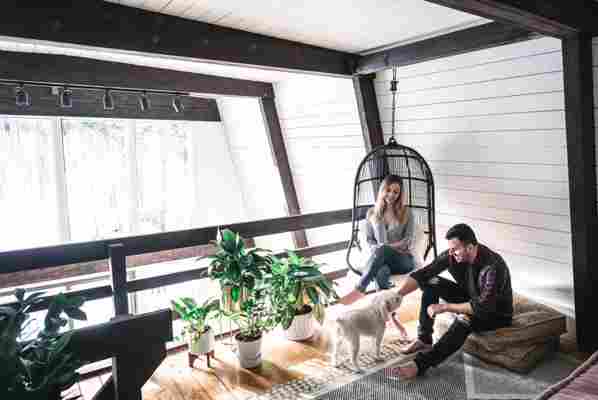
Over the years, millennials have gotten a bad rep for being a group of kids who spend their paychecks on avocados rather than real estate, but that’s not actually the case. They still might buy a lot of avocados, sure, but in fewer than three years the oldest millennials will be turning 40, meaning a portion of that generation is entering middle age and their prime spending years. Not to mention that by next year, according to the Pew Research Center , this age group will overtake the Baby Boomers as America’s largest generation (with the most spending power). With that comes a bit of a shift in the retail market , specifically within home decor, as brands attempt to accommodate their newest biggest client.
If you’re wondering why the market needs to change, it’s because not all generations interact with brands in the same way—they each have their own unique lifestyles, and they translate directly into what and how they buy. For example, you have probably heard how millennials were the kiss of death for fast-casual restaurants like Applebees, starter homes, and even doorbells . Meanwhile, Baby Boomers killed five-and-dime stores, automats, and diners when they came of age. Each generation has its own quirks and habits.
That’s why with the younger generation growing into its shoes (and bank accounts), trend forecasters and industry leaders are already theorizing on how things are going to change—and adapting accordingly.
Brands Can’t Rely on Excess Anymore
Gone are going to be the days of buying seven different decorative chairs that are tucked into random corners around the house, and impulse-purchased lamps that don’t really have a place to go. Millennials shop with purpose and don’t really like to stock up on unnecessary things.
“Millennials today are looking for products that do more than one thing. They’re very conscious of what they’re going to buy or what they’re going to upcycle,” Nancy Fire, the trend forecaster behind Design Works International and Design Director of HGTV Home , shares. “They don’t want to over-buy, so what they do buy has to be specifically right for them.” For example, Fire recalls a moment when she tried to pawn off a stack of extra towels from her studio to a younger employee, but he frowned at the excessive amount and just asked for one. “He didn’t get the concept of a linen closet,” she notes, highlighting how stockpiling on so many towels seemed like an unattractive waste. Millennials aren’t into cluttering up their homes.

Millennials Use Their Homes as Creative Outlets
According to Helen Jamieson, a millennial trend forecaster who has worked with Trend Bible (specialists in forecasting the future of life at home with a real focus on interiors), one major influence in the way millennials want to decorate and style their home is social media, which is changing the home decor scene and who sells it. “Inspired by so much access to imagery of beautifully curated homes and home design through media platforms like Pinterest, Instagram, and a plethora of blogs and other online publications (including Apartment Therapy), the home has become a new creative outlet,” she says. So much so that sales of fashion are down and sales of homeware are up. “Home decor is becoming a new form of personal identity. Fashion brands understand this and many of them have seen success through launching homeware collections (H&M for example).”
Jamieson has also found that millennials tend to be less focused on the “forever home” the way boomers are, which affects what kind of decor is offered by retailers. “This more transient mindset means that they are looking for less permanent home decor options and furniture that it portable, adaptable, and easy to move,” she explains.
Another millennial feature that’s driving trends is that they like staying in more and more. “Netflix and food delivery services like Seamless make it easy to have great food and entertainment experiences in the comfort of the home. Even more reason to make the home a great environment to spend time, socialize or just snuggle up. Last year we saw a surge in luxury drink trolleys, glassware and cocktail kits for the home, a real sign that people are investing in having a good time at home,” Jamieson says.
It’s Not So Much About Aesthetics Changing, but the Experience Changing
As you have probably noticed, we haven’t really touched on how the aesthetic of decor will be changing thanks to this new shift. You can’t really pigeonhole a group of people that range between the ages 21 to 37 into one lifestyle, so it’s not so much that the aesthetic of home decor is going to change to accommodate Millennials, but that the experience of brands is going to change.
“The traditional experience of shopping for furniture in a showroom that baby boomers are accustomed to can be overwhelming and stressful,” Duncan Blair, Director of Marketing at Article, explained, pointing out how crowded showrooms are usually in inconvenient locations, are a poor approximation of a real home environment, have long-lead delivery times, and can be packed with disingenuous sales people. Millennials prefer a different kind of experience, and often like to make their purchases online. Knowing that, brands are adapting to help their customers make informed and confident decisions.
“With the advent of augmented reality, the lines between traditional brick-and-mortar and online stores have become blurred,” the team of editors at Wayfair share. “ AR technology has solved one of the biggest pain points consumers face when shopping online, as they’re often unsure how a product will look and fit in with the existing aesthetic of their home.” That’s why Wayfair created the “View in Room” app feature, which helps customers visualize 3D furniture and décor in their homes before they buy. “This new way to shop provides customers with the same great experience online that they would in store, from the comfort of their home.” Whereas before buying a couch or a big-ticket item online seemed like a gamble, now it’s becoming the norm.
Millennials Want to Connect on a More Personal Level with Brands
There’s a reason things like the mall and the department store are on the decline: Millennials want a connection with the brand they’re buying from. “Stories and shared brand experiences make people feel like they’re participating in something that’s bigger than themselves,” Blair points out. In fact, a recent report by the National Retail Federation found that millennials want to feel emotionally connected to the purchase experience.
Fire pointed out how bigger department stores or big-box retailers like Target are trying to bring smaller brands onto their shelves, mainly because they appeal to a certain lifestyle that people are trying to tap into, and not just selling cold, hard products. “Years ago it would be commercial, in your face advertising,” she says. Now consumers want to connect with the story, the mission, and the people behind the brands.
…Which Leads Us Into the Importance of Eco-Friendliness, Ethics, and Sustainability
More and more millennials are moving away from fast fashion brands and big box chains and onto smaller brands that are trying to actively connect back to the community and, in a way, the consumers themselves.
“Are you volunteering, are you doing something for your community? These are questions some millennials look at when purchasing,” Fire explains. “For example, we’re a design studio so we often have extra fabric left over, and we send our fabrics to companies that give them to refugee women. These women are skilled at sewing and from these fabrics they are able to sell their wares. We’re connecting to other people in our industry that need what we have.” This kind of “plugging back into the community” is what this generation is looking for, because it feels like real people are behind the brands and they stand for something.
Which is why millennials take great stock in companies and products that are sustainable and eco-friendly. In fact, a Nielsen global online study found that millennials continue to be most willing to pay extra for sustainable items, where almost three-out-of-four respondents answered they would. “The great thing about eco-friendly, sustainable and local items, as well as purchases that support a charitable cause, is that there is a story that people can connect with and share,” Blair explains. In fact, Article’s Stria rugs are made of recycled bottles, their new Velo rug is constructed with a combination of recycled plastic bottles and recycled bike tire rubber, and their range of Alpaca wool throws are certified fair trade. They themselves are walking the walk.
“I love the Velo rug because mountain biking is a personal passion, and finding another use for what would otherwise be landfill is a great message for me to share with my friends,” Blair says. “Similarly, we recently ran a campaign for Valentine’s Day, donating $10 from every purchase to guide dog associations across North America. We ended up donating more than $37,000 and it made our customers feel like their purchase during that time period really made a difference—it’s now a story they can share while lounging on their Article sofa at home with friends.”
But That Doesn’t Mean Baby Boomers Are Being Left Behind
Interestingly enough, just because baby boomers are losing their number one spot in terms of purchasing power doesn’t mean they’re being left behind. Instead, they’re embracing the change. “Everyone wants nice things,” Fire points out. The older generation is now at the point where they’re buying second homes and apartments, and as they look for stuff to fill up these new properties, they’re being turned to the brands that millennials love (and might not have necessarily found on their own). “They’re now buying from companies like Joybird and Article because they see them on social media—and they also hear about them from their kids. For example, my kids turned me onto cool companies I might have never known. It’s more about sharing knowledge and making it a positive thing,” Fire says.
We’re all evolving forward together.
